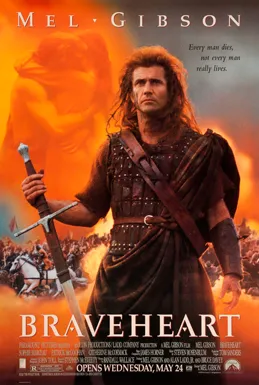Historical accuracy of Braveheart

Historical accuracy of Braveheart

Characters
William Wallace
Wallace was a key figure in the First War of Scottish Independence, but the film fictionalizes his origins, specific motivations (like prima nocta), and personal life.
Robert the Bruce
A real and crucial figure who became King Robert I, but his relationship with Wallace, presence at Falkirk, and early loyalties are heavily dramatized and inaccurate.
King Edward I
Edward I "Longshanks" was a real king known for his campaigns against Scotland, but the film portrays him as a more one-dimensional, almost pantomime villain.
Princess Isabella
Isabella of France was real but was a child living in France during Wallace's uprising, married Edward II years later, and never met Wallace. Her affair is fiction.
Prince Edward
The future Edward II was real, but his portrayal as overtly weak and effeminate, along with the invented relationship with Phillip, is historically inaccurate and exaggerated.
Stephen (the Irishman)
Stephen is an entirely fictional character created for comic relief and to represent the common man joining Wallace's cause.
More characters
Hamish Campbell
Hamish and his father are fictional characters representing Wallace's close comrades and the heart of the Scottish resistance.
Murron MacClannough
While Wallace's wife (likely Marion Braidfute) was allegedly killed by an English sheriff, the name Murron and the specific events surrounding her death are fictionalized.
Mornay
Represents the faction of Scottish nobility whose shifting allegiances and self-interest sometimes hindered the independence movement, though not a specific single person.
Craig
A fictional character representing the older generation passing on the stories of resistance.
Story
Prima Nocta enforced by English lords
There is no credible historical evidence that the "right of the first night" was ever formally instituted or practiced in medieval Britain.
Wallace's rebellion sparked by wife's murder
Tradition holds Wallace's rebellion began after his wife (Marion Braidfute) was killed by the English Sheriff of Lanark, though the film's specific details are invented.
Battle of Stirling Bridge
The film omits the crucial bridge, the key tactical feature of the actual battle, depicting it instead as an open-field engagement.
Wallace sacks York
Wallace raided northern England but never reached or sacked the city of York.
Wallace's affair with Princess Isabella
Isabella was a child in France at the time, did not meet Wallace, and the timeline makes the affair and resulting lineage impossible.
Robert the Bruce betrays Wallace at Falkirk
Robert the Bruce was not present at the Battle of Falkirk and did not betray Wallace on the battlefield as depicted.
Wallace captured via noble betrayal
Wallace was captured after being betrayed by a Scottish knight, Sir John Menteith, who was loyal to Edward I, though not exactly as depicted with the nobles shown.
Battle of Bannockburn follows execution
Robert the Bruce did lead the Scots to a decisive victory at Bannockburn in 1314, securing de facto independence years after Wallace's death.
Wallace's execution details
Wallace was executed in London by being hanged, drawn, and quartered for treason. His defiance is noted, but his final words ("Freedom!") are undocumented invention.
Use of Schiltrons at Falkirk
The Scots did employ pike formations called schiltrons at Falkirk, though they ultimately proved vulnerable to English longbows and cavalry.
Edward I throws Phillip out window
This dramatic event involving Prince Edward's fictional favourite, Phillip, is entirely fabricated.
Wallace speaks multiple languages
While likely literate and possibly knew Latin or French, the extent of his education and travels (like to Rome) is undocumented and likely exaggerated in the film.
Disunity among Scottish nobles
Internal divisions, shifting loyalties, and self-interest among the Scottish nobility were significant factors during the Wars of Independence.
Setting
Use of Scottish Highlands landscape
Key events like the Battles of Stirling Bridge and Falkirk actually took place in the Scottish Lowlands, not the dramatic Highland scenery predominantly shown.
Costumes: Kilts and Plaid
The short, pleated kilts worn are anachronistic by several centuries; clothing of the period included tunics, trews (trousers), and possibly early belted plaids.
Weaponry and Armour
Swords, axes, spears, and bows were appropriate, but the prevalence of large two-handed swords like Wallace's is debatable, and armor depictions are inconsistent.
Time Period: Late 13th/Early 14th Century
The film correctly places the events within the timeframe of the First War of Scottish Independence under Edward I's reign.
Woad Face Paint
The use of blue face paint by warriors is historically inaccurate for this period and people; it was associated with earlier Pictish tribes.
Castle Architecture
The castles generally fit the medieval period, though specific designs may be inaccurate or serve primarily cinematic needs rather than strict historical accuracy.
Stirling Bridge (Absence thereof)
Omitting the crucial bridge from the Battle of Stirling fundamentally misrepresents the historical tactics and significance of the victory.
Language (Modern English)
Characters would have spoken Middle Scots, Middle English, Norman French, and Latin; using modern English is a standard film convention for accessibility.
Gritty, Muddy Aesthetic
The film effectively portrays the often harsh, brutal, and muddy reality of medieval life and warfare, avoiding over-sanitization.
